Note. The following special tools are required for the following procedures: Stillson wrench and pinion flange puller (to replace the drive gear oil seal); the tools listed above, plus a bearing puller (for disassembly); press with backing plates, sensitive low range torque wrench and dial gauge (for assembly).
Replacing the drive gear oil seal
1. Jack up the front of the car and place it on jack stands under the frame side members.
2. Remove the drain plug and drain the oil from the front axle housing.
3. Mark the position of the front driveshaft in relation to the drive gear flange, then disconnect the driveshaft from the flange and tie it aside to the frame side member with a piece of wire.
4. Mark the position of the drive gear in relation to its flange (the final drive gear with related components is shown in the accompanying illustration).
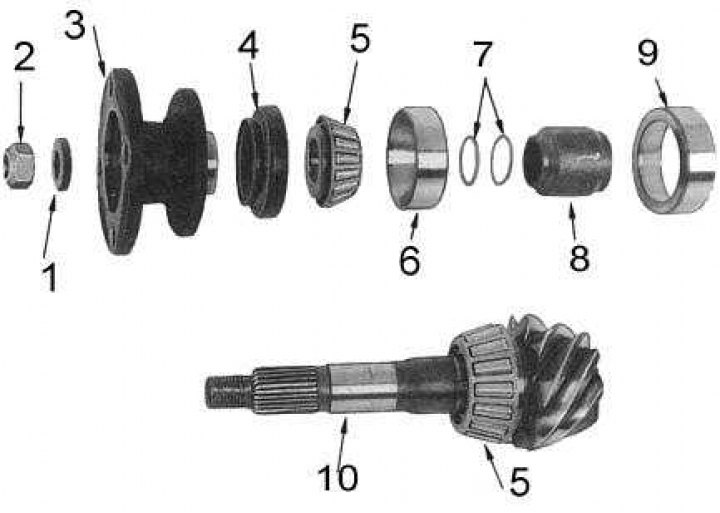
1 - washer; 2 - nut; 3 - flange; 4 - stuffing box; 5 - bearing; 6 - clip; 7 - adjusting washers; 8 - remote bushing; 9 - cup; 10 - drive gear
5. Secure the flange with a large Stillson wrench and loosen the pinion nut.
6. Using a puller, remove the flange from the gear.
7. Using a sliding hammer or a suitable lever, remove the oil seal from the crankcase.
8. Clean the oil seal housing in the crankcase and check its walls for burrs and burrs.
9. Pack the space between the lips of the new oil seal with a lithium based multipurpose grease. Lubricate the outer edge of the oil seal with special grease and seat the latter perpendicularly into the final drive housing flush with its end face.
10. Using a soft-faced hammer, install the drive gear in place, making sure that the marks made during the dismantling process are aligned.
11. Lubricate the nut with sealant, put on the washer and tighten the nut with a force of 196÷284 Nm.
12. Connect the cardan shaft to the flange (follow the alignment of the marks applied during the dismantling process). Tighten the fixing bolts with a force of 78÷88 Nm.
13. Pour the required amount of oil of the required grade into the axle housing (see tables of sizes and adjustments at the end of the guide).
Removing
1. Remove the front wheel hubs and drive shafts.
2. Mark the position of the front propeller shaft in relation to the final drive gear flange, then disconnect the shaft from the flange. Tie the shaft aside to the frame element with a piece of wire.
3. Give fixing nuts, remove washers and release a brake tube from an arm. Disconnect the final drive assembly from the front axle housing. Remove from assembly and discard gasket.
Note. The compilers of this Guide recommend using an assistant to remove the main gear - the weight of the assembly is very significant.
4. Check the axle housing for the presence of metal filings inside it, the presence of which should be regarded as a sign of final drive wear. In this case, the assembly should be completely disassembled and defective or worn components should be replaced.
5. Clean the mating surfaces of the axle housings and final drive assembly. Make sure that no debris gets inside the crankcases.
Installation
Installation is in the reverse order.
1. Install a new gasket on the axle housing (gray side to the bridge).
2. Install the final drive assembly, screw on the fixing nuts and tighten them with a force of 54÷64 Nm. Connect the cardan shaft. Follow the alignment of the marks applied during the dismantling process. Tighten fasteners with a force of 78÷88 Nm.
3. Reinstall the drive shafts and front wheel hubs. Pour the required amount of oil of the required grade into the axle housing (see tables of sizes and adjustments at the end of the guide).
Disassembly
1. Remove the final drive assembly. Clamp her in a vise.
2. Before dismantling the assembly, perform the following checks:
- Using a dial gauge mounted against the mating surface of the crankcase assembly, check the runout of the final drive gear. If the measurement result exceeds 0.08 mm, check if there are foreign particles between the gear and the differential case. If they cannot be found, replace the differential box.
- Using a dial gauge, check the radial play of the driven gear at four points. The nominal value of the gap is 0.15÷0.20 mm. If the measurement result exceeds the specified value at any of the tested points (with an allowable runout value) replace without fail the driven and driving gears, or the differential box (according to circumstances).
3. Put landing marks on covers of lateral bearings and surfaces adjoining to them of a case of the main transfer (see accompanying illustration).
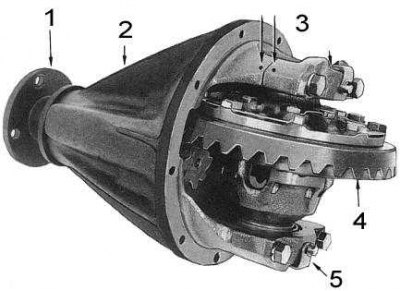
1 - leading flange; 2 - crankcase; 3 - landing marks; 4 - driven gear; 5 - locking tongue
4. Remove lock tongues from covers of lateral bearings, give fixing bolts and remove covers and adjusting nuts.
5. Use a wooden lever to support the driven gear with the differential assembly, pushing them out of the final drive housing. Try not to confuse the side bearing races - for a guarantee, put identification marks on them.
6. Mark position of an axis of satellites concerning a flange of a leading gear wheel.
7. Secure the flange with a large Stillson wrench and loosen the pinion nut.
8. Using a puller, remove the flange from the drive gear, then remove the gear itself, the spacer and shims from the crankcase (use a soft-faced hammer if necessary).
9. Using a sliding-face hammer or suitable lever, remove the oil seal from the crankcase, then remove the pinion outer bearing cone.
10. Mark the landing position of the driven gear on the differential box.
11. Unfold locking plates (if any) fixing bolts of the driven gear of the final drive.
12. Where required, straighten the tabs of the lock plates of the driven gear mounting bolts.
13. Give in a diagonal order the bolts of the driven gear, remove and discard the lock plates (if any).
14. Using a soft-faced hammer, gently tap the driven gear around the perimeter to separate it from the differential case.
15. On models with 2 satellite differential (components are shown in the accompanying illustration) Using a drift, knock out the pinion axle lock pin from the side of the driven gear facing the differential box and remove the pinion axle, pinion gears, differential side gears and thrust washers.
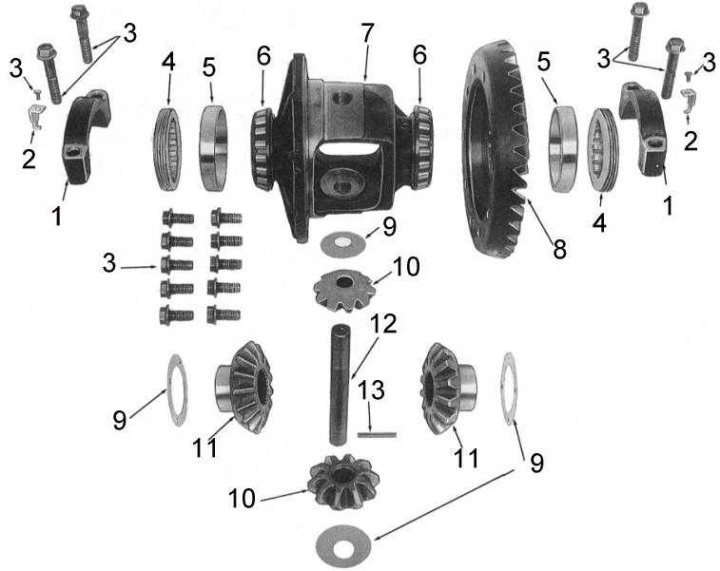
1 - cover; 2 - locking tongue; 3 - bolt; 4 - adjusting nut; 5 - clip; 6 - bearing; 7 - differential box; 8 - driven gear; 9 - thrust washer; 10 - satellite; 11 - differential side gear; 12 - axis of the satellites; 13 - pin
16. On models with 4 satellite differential (see accompanying illustration) mark the installation position of the differential box halves (lids and boxes), then give the bolts securing them to each other. Split the differential case in half and remove the pinion axle assembly, pinion pinions, side gears and thrust washers.
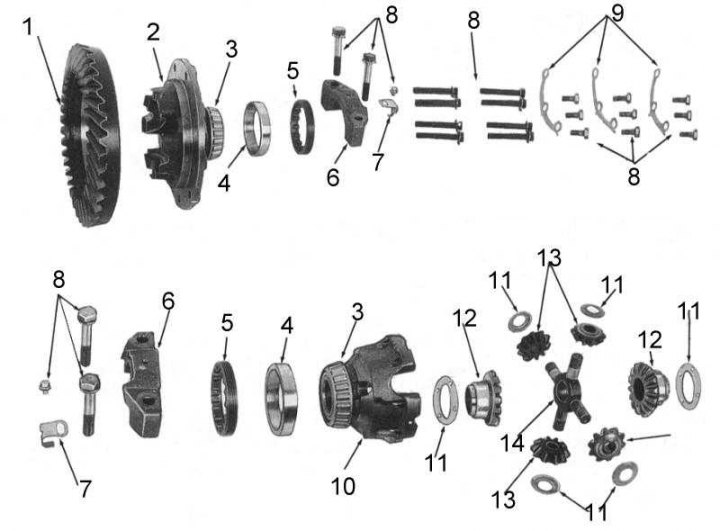
1 - driven gear; 2 - differential box cover; 3 - bearing; 4 - clip; 5 - adjusting nut; 6 - cover; 7 - locking tongue; 8 - bolts; 9 - lock washers; 10 - differential box; 11 - thrust washer; 12 - differential side gear; 13 - satellites; 14 - the node of the axes of the satellites
Cleaning and checking the condition of components
1. Wash all components in solvent and dry with compressed air.
2. Check the teeth of the driven and drive gears for signs of wear, chips or other damage.
3. Check the pinion gears, differential side gears, thrust washers and pinion axles for signs of wear and damage.
4. Inspect the differential box for cracks or other damage.
5. Check the side bearings and their cups for signs of wear, discoloration or other damage. If necessary, remove the bearing cones from the box using a puller.
6. Check the pinion bearings for signs of wear, discoloration or other damage. If necessary, replace the bearings, for which:
- Using a suitable puller, remove the inner bearing cone and spacer from the pinion gear (if one is installed).
- If necessary, put on the drive gear remote sleeve. Make sure that the bushing is installed with the beveled end towards the gear. Using a press with backing plates, install a new bearing cone. Remember that the force should be applied only to the inner race of the bearing and until the distance sleeve rests against the shoulders of the drive gear.
- Using a brass drift, remove the bearing cups from the final drive housing.
- Carefully install the new cups into the crankcase until they are firmly seated in the hangers.
7. Check the drive gear flange mating surface for nicks and signs of wear. Replace if necessary.
Assembly
Assembly is carried out in the reverse order of dismantling.
1. Lubricate the required grade components with lubricant.
2. On models with a 2-satellite differential, assemble the box:
- Install the side gears, thrust washers, pinion gears and pinion shaft into the box. Do not install the lock pin at this stage.
- Using a blade-type feeler gauge, measure the clearance between the side gear thrust washer and the differential case wall. If the measurement result is outside the range of 0.15÷0.20 mm, replace the thrust washers with new ones of the appropriate thickness.
- Align the axis of the satellites, aligning the locking holes and install the pin in place until it is fully seated in the differential box.
- Lubricate the pinion gears and side gears with the correct grade of grease and check for free rotation.
3. On models with a 4-satellite differential to assemble the box:
- Install the side gears, thrust washers, satellites and the satellite axle assembly into the main half of the box.
- Press flatness gauge (edge of steel ruler) against the rear surface of the side gear thrust washer on the upper side of the differential and, with the gears blocked from rotation, measure the distance between the mating surface of the differential box and the flatness rib using a vernier caliper. Record the measurement result (A).
- Press the flatness gauge against the mating surface of the differential case cover and use a vernier caliper to measure the distance between the contact surface of the side gear thrust washer and the rib of the gauge. Write down the result (IN).
- Calculate the thrust washer clearance of the side gear by subtracting dimension B from dimension A. If the result of the calculation is outside the range of 0.15÷0.20 mm, change the thrust washers to new ones of the required thickness.
- Assemble the two halves of the differential box with each other (follow the alignment of the landing marks applied during dismantling). Screw in the fixing bolts and tighten them with a force of 64÷74 Nm.
- Lubricate the differential gears and thrust washers with the correct grade of grease and check the gears for free rotation.
4. On models with a 2-planet differential, lubricate the surfaces of the differential box in contact with the final drive gear with a fixing sealant.
5. Install the driven gear on the differential case, using a soft-faced hammer if necessary. Make sure that the landing marks applied during the dismantling process are aligned.
6. Lubricate the fastening bolts of the driven gear with fixing sealant, screw the bolts, installing new locking plates under them (if any).
7. Tighten the bolts with a force of 132÷152 Nm in a diagonal manner, at the same time lightly tapping on their heads with a hammer. Where required, bend the tabs of the locking plates with a center punch.
8. Lubricate the outer edge of the new pinion oil seal with the correct grade of grease. Fill the space between the seal lips with a lithium based multipurpose grease. Install the bearing and seal into the crankcase.
9. Lubricate the drive gear rear bearing with the correct grade of grease, then install the drive gear, spacer and shim into the crankcase. While holding the gear still, use a soft-faced hammer to tap the flange onto the gear.
10. Make sure that the threads on the drive gear and the mounting nut are not contaminated with grease or oil, grease the threads of the nut with sealant.
11. Install the washer, then screw on the nut and tighten it with a force of 196÷284 Nm.
12. Rotate the drive gear several times in both directions. Put a torque wrench on the mounting hook and determine the pinion bearing preload. If the preload value is outside 1.3÷1.6 Nm, change the bearing adjusting washer to another one of the appropriate thickness.
13. Install the cups on the side bearing cones and place the differential/driven gear assembly into the final drive housing, making sure the bearing cups are seated correctly. If old side bearings are used, make sure that their cups are installed on the same sides as before disassembly.
14. Screw the adjusting nuts of the side bearings, making sure that they are correctly inserted into the threads in the final drive housing.
15. Achieve the alignment of the landing marks of the side bearing caps and the final drive housing, install the bearing caps and tighten the bolts of their fastening by hand. If the cap does not sit flat when pressed down by hand, the bearing adjusting nut is not properly aligned with the cap.
16. Using a dial gauge, check the radial play of the final drive gear. If the measurement result exceeds 0.02 mm, loosen the adjusting nut on the side of the drive gear and tighten the opposite one by the same number of turns. If the play is less than 0.15 mm, reverse the procedure.
Note. If the amount of axial play is different at different points of the driven gear, check whether foreign particles have fallen between the gear and the differential case. If such particles cannot be detected, replace the drive and driven gears, or the differential case.
17. Rotate the drive gear several times in both directions, then use a torque wrench on its fastening nut to check the total differential preload. If the measurement result is outside the range of 1.8÷2.5 Nm, loosen or tighten both adjusting nuts accordingly. Having achieved the required value of the differential preload, once again check the amount of radial play of the driven gear.
18. Tighten the side bearing cap bolts with a force of 93÷103 Nm.
19. Install the lock tabs and firmly tighten the bolts of their fastening. By pressing the plunger of the dial gauge to the bearing surface, check the amount of runout of the driven gear of the final drive. If the measurement result is greater than 0.8 mm, remove the gear from the differential case and check if there are foreign particles between them.
20. Lubricate the surface of the teeth of the driven gear with Prussian blue, or a mixture of red lead and oil, then, fixing the flange of the drive gear, rotate the driven gear in both directions.
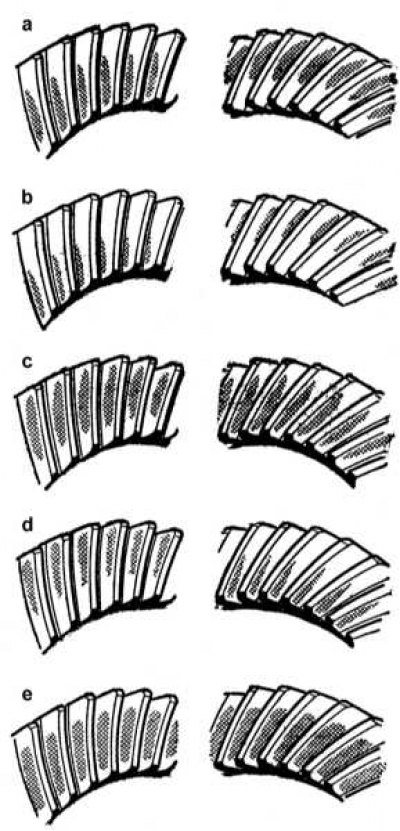
The location of the contact patch in the gearing of the final drive gears (left column is forward side, right column is reverse side):
- a and b - incorrect contact, it is necessary to move the drive gear away from the driven gear, reducing the thickness of the adjusting ring;
- c and d - incorrect contact, it is necessary to move the drive gear to the driven gear, increasing the thickness of the adjusting ring;
- e - the correct location of the contact patch.
21. Inspect the surfaces of the driven gear teeth and compare the shape of the contact patch with the supplied reference card (see accompanying illustration). If the desired shape of the contact patch cannot be achieved, both gears (led and leading) must be replaced.
22. Install the final drive assembly, drive shafts and front wheel hubs.